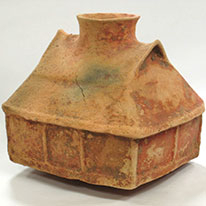Past Exhibitions
- The Ancient Origins of Tottori and Hyogo Prefectures
- January 2, 2020 - February 26, 2020
Brought together in this exhibit are objects ranging in date from the Jōmon period (10,000–300 BCE) to the Kamakura period (1185–1333). Following an exchange of archaeological relics between Hyōgo Prefectural Museum of Archaeology, The Tatsuno City History and Culture Museum (TCHCM), the Tottori Prefectural Museum, and Kyoto National Museum, of the objects on display here — each of which exemplifies the material culture of this region — are twenty or so loaned objects from these institutions. One of them is an earthenware miniature dwelling from the Tottori Prefectural Museum, which is dated to the Yayoi period (ca. 300 BCE–300 CE). From the Kofun period, there are earthenware vessels belonging to The Hyōgen Prefectural Museum of Archaeology and a terracotta tomb figurine (haniwa) in the shape of a horse from TCHCM. The Kofun period lasted roughly from the 3rd century to the 6th century. Its name refers to the tumuli that emerged at this time from which many of the objects serving as the basis for the period’s dating have been excavated. Meanwhile, unglazed ceramic ware (sueki) and ancient bell-shaped bronzes (dōtaku) excavated in Tottori Prefecture and Hyōgo Prefecture are on loan from the Kyoto National Museum collection.












